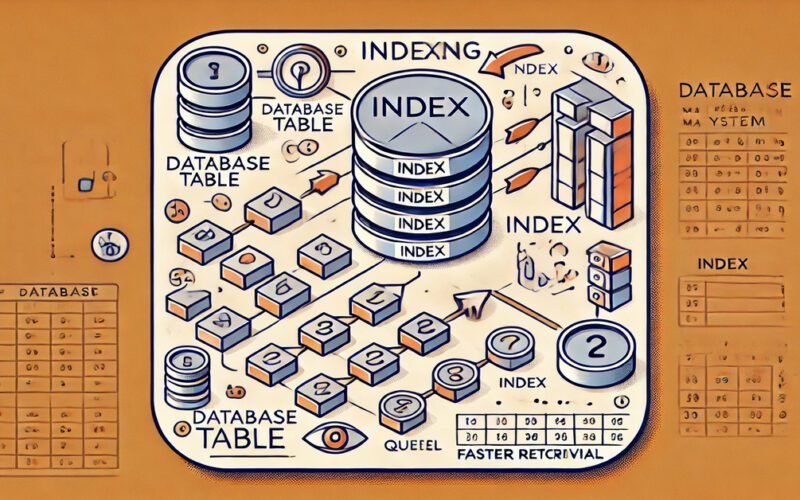Summary: Indexing in DBMS enhances query performance by allowing quick data access through structured indexes. While it improves retrieval speed, it may also increase storage needs and slow down write operations.
Introduction
A Database Management System (DBMS) is essential for efficiently storing, managing, and retrieving application data. As databases grow, performance optimisation becomes critical to ensure quick access to information. One of the most effective techniques for enhancing database performance is indexing in DBMS.
Indexing allows the system to locate and retrieve data quickly by reducing the amount of data scanned during queries. By creating an index, databases can accelerate search operations, ensuring faster response times and improved efficiency in handling large datasets. In this guide, we will explore the role of indexing in optimising DBMS performance.
What is Indexing in DBMS?
Indexing in DBMS is a technique for enhancing the speed of data retrieval operations on a database table. It involves creating an index data structure, which helps the database quickly locate the required rows without scanning the entire table.
The index stores the values of one or more columns in a sorted order, enabling faster searching and retrieval of records.
Role of Indexes in Improving Query Speed
Indexes play a crucial role in optimising query performance. When a query is executed, the database engine uses the index to directly locate the rows that match the query conditions.
This significantly reduces the number of disk I/O operations and improves response time, especially for large databases with millions of records. Without indexing, the database would have to perform a full table scan, which is slow and resource-intensive.
Comparison of Indexing with Book Indexes
Indexing in a DBMS is similar to indexing at the back of a book. Just as a book index helps you quickly find specific topics or keywords without reading every page, a database index allows you to retrieve specific data without scanning the entire table.
This analogy helps to understand how indexing reduces the time needed to find relevant information.
Types of Indexes in DBMS
Indexes in DBMS play a crucial role in optimising database performance by improving the speed of data retrieval operations. By creating indexes, databases can quickly locate and access the required data without scanning the entire dataset.
Different types of indexes exist to handle various data retrieval scenarios, each designed to meet specific query needs. Understanding these types helps implement the right index based on the application’s requirements. Let’s explore the most common types of indexes used in DBMS.
Primary Index
The primary index is one of DBMS’s most fundamental and widely used indexes. It is directly related to a table’s primary key. The system automatically creates a primary index when a primary key is defined. This index stores the values of the primary key in sorted order, ensuring that each entry is unique.
The primary index is handy when retrieving rows based on the primary key. Since it is ordered, searching for a specific record becomes much faster, as the database can use binary search or similar techniques to find the data.
Example of Primary Index
Consider a table Employee with columns such as Employee_ID, Employee_Name, and Department. If Employee_ID is defined as the primary key, a primary index is created in this column. When you query the database to find an employee by their Employee_ID, the primary index helps locate the employee’s record without scanning the entire table.
Secondary Index
While the primary index is tied to the primary key, the secondary index is an additional index that can be created on columns with non-primary keys.
The secondary index is useful when queries are frequently made on columns not part of the primary key but still require fast data access. This index allows for faster searches on attributes other than the primary key.
Differences from Primary Index
The key difference between the secondary and primary indexes is their association with the table. The primary index is directly related to the primary key and ensures uniqueness. On the other hand, the secondary index is not associated with the primary key and can allow duplicate values.
Moreover, the primary index stores data in sorted order, while the secondary index doesn’t necessarily maintain an order, depending on the database implementation.
Example of Secondary Index
In the Employee table, suppose users frequently query the Department column. You can create a secondary index on the Department column to speed up searches. If you want to find all employees in the “HR” department, the secondary index on the Department field will be used to retrieve the data quickly.
Clustered Index
A clustered index determines the physical order in which data is stored in the database. Each table can have only one clustered index because the actual data rows are stored in the order specified by the clustered index.
It is beneficial when you often retrieve data ranges based on a specific field, as the database can retrieve continuous data blocks more efficiently.
How Clustered Indexes Work
Clustered indexes work by sorting the entire table based on the column specified in the index. If the column on which the index is created is a primary key, the clustered index is automatically created.
When you run a query that requests a range of values, the database can jump directly to the relevant section of the sorted data, speeding up the retrieval process.
Example of Clustered Index
Suppose you create a clustered index on the Employee_ID in the Employee table. In that case, the entire table is sorted by Employee_ID. When you run a query like SELECT * FROM Employee WHERE Employee_ID BETWEEN 100 AND 200, the database can quickly find the range of rows and return the data in one operation.
Non-Clustered Index
Unlike the clustered index, a non-clustered index does not affect the physical order of the data in the table. Instead, it creates a separate structure that holds the reference to the actual data.
Non-clustered indexes are highly beneficial for speeding up queries involving columns frequently used in the WHERE clause but not part of the clustered index.
Benefits and use cases of a non-clustered index are:
- Faster Reads: Non-clustered indexes improve the read performance for columns not part of the primary key.
- Multiple Indexes: Multiple non-clustered indexes can be created on a single table, allowing you to optimise performance for several columns.
- Use Case: A non-clustered index is helpful for queries involving searches on fields like Employee_Name in the Employee table, while the primary or clustered index might be on Employee_ID.
Example of Non-Clustered Index
In the Employee table, you could create a non-clustered index on the Employee_Name column. This index does not alter the storage order of the table but keeps a reference to the rows where the employee name is stored, speeding up searches that involve employee names.
Unique Index
A unique index enforces the uniqueness of the values in the indexed column. It is often created on columns that require unique values to maintain data integrity. The system automatically creates a unique index when a unique constraint, such as a primary key or unique key, is applied to a column.
Ensuring Data Integrity with Unique Indexes
Unique indexes are essential for enforcing data integrity by ensuring that no two rows have the same value for the indexed column. This is particularly important for business-critical data such as social security numbers, email addresses, or product codes, where duplicate values would lead to errors or inconsistencies.
Example of Unique Index
In the Employee table, suppose each employee has a unique Email_ID. A unique index can be created on the Email_ID column to ensure no two employees share the same email address, ensuring data integrity.
Composite Index
A composite index includes multiple columns. It is useful when queries frequently involve combinations of columns rather than just a single column. When used correctly, composite indexes can significantly enhance query performance.
Indexes on Multiple Columns for Complex Queries
Composite indexes are often used when queries involve WHERE clauses that filter on multiple columns. By indexing multiple columns together, the database can quickly locate records based on all indexed fields, avoiding various searches.
Example of Composite Index
In the Employee table, suppose many queries involve both Department and Employee_Name. A composite index on Department and Employee_Name would speed up these queries by allowing the database to search on both columns simultaneously rather than for each separately.
How Indexing Works in DBMS
Exploring the internal mechanisms that drive indexing is essential to understanding how it works. Indexing relies on specific data structures and processes to optimise performance. However, it also presents inevitable trade-offs that need to be considered.
Behind-the-Scenes Process of Indexing
In a DBMS, indexing functions similarly to the index in a book, where entries point to pages containing relevant information. The system doesn’t scan the entire table when a query is executed. Instead, it uses the index to locate the data directly, leading to a faster retrieval.
During the creation of an index, the DBMS sorts the indexed column(s) to build references, or pointers, to the actual data in the table.
Indexes are updated whenever the data in the underlying table changes. For instance, if a new row is added or a value is modified, the index must reflect these changes to maintain accuracy.
Data Structures Used in Indexing (B-trees, Hash Indexes, etc.)
Indexes in DBMS are typically built on specific data structures designed for quick access. Two of the most commonly used data structures are:
B-trees
B-trees are widely used because they maintain a balanced tree structure. Each node in a B-tree contains multiple keys that guide the search path.
As the tree grows, it rebalances itself, ensuring that the search time remains consistent even as the dataset increases. B-trees are ideal for range queries, where you need to search between a set of values.
Hash Indexes
Hash indexes use a hash function to map keys to a location in memory. These indexes are excellent for equality-based searches, where you are searching for an exact match.
However, hash indexes are not well-suited for range queries, as the hash function scatters the data without preserving any order.
How Indexes Accelerate Data Retrieval
Indexes drastically reduce the time required for data retrieval. Without an index, the DBMS must perform a full table scan, checking each row to find matching records. With an index, the system directly navigates to the relevant data, skipping unnecessary rows. This results in faster execution of SELECT queries, especially in large databases.
Trade-Offs: Space Complexity vs. Speed Improvement
While indexes improve query performance, they come with trade-offs. Indexes consume additional disk space because they store a copy of indexed columns alongside the data pointers. This can lead to significant storage overhead in large databases.
Additionally, indexes slow down write operations (INSERT, UPDATE, DELETE) because every change to the table requires updating the associated index. Balancing the need for speed with the storage and maintenance costs is key to effective indexing in DBMS.
Advantages of Indexing in DBMS
Indexing in DBMS offers significant advantages that boost database performance and efficiency. By creating an index, the system can quickly locate and access data, leading to faster query execution and smoother operations, especially with large datasets. Below are the key benefits of using indexing in a DBMS:
- Faster search and retrieval of data: Indexes allow databases to find specific rows quickly without scanning the entire table.
- Reduced disk I/O operations: Indexing minimises the need to access the disk repeatedly, improving overall efficiency.
- Optimised performance for large datasets: Indexes help effectively manage and query vast data.
- Efficient execution of complex queries: Queries with multiple conditions or joins run faster with well-designed indexes.
Disadvantages of Indexing
While indexing enhances query performance, its drawbacks can affect overall database efficiency. It’s essential to carefully consider these limitations before implementing indexing in your DBMS.
- Increased storage usage: Indexes require additional disk space, leading to significant storage overhead, especially for large datasets.
- Slower write operations: Inserting, updating, or deleting data becomes slower as the index needs to be modified with each write operation.
- Maintenance overhead: Indexes need regular maintenance to avoid fragmentation and ensure optimal performance.
- Over-indexing issues: Too many indexes can degrade database performance instead of improving it.
Best Practices for Indexing in DBMS
To ensure optimal database performance, following best practices when implementing indexes is essential. Proper indexing can significantly speed up data retrieval, but poor indexing strategies may lead to inefficiency. Here are some best practices to maximise the benefits of indexing in a DBMS:
- Use appropriate indexes: Based on your query needs, select the right index type (clustered, non-clustered, composite).
- Avoid over-indexing: Too many indexes can slow down write operations.
- Regularly maintain indexes: Rebuild or reorganise fragmented indexes.
- Monitor index performance: Analyse query plans and identify underused indexes.
- Balance reads and writes: Prioritise indexing based on workload patterns.
When to Avoid Indexing
While indexing can significantly improve database performance, there are certain situations where creating an index may be detrimental. Recognising when indexing is unnecessary or could slow down operations instead of speeding them up is essential. Here are the scenarios where you should avoid using indexes:
- Small tables: Indexing small datasets offers minimal performance gains, as a full table scan can be faster.
- Frequent write operations: Due to index maintenance, tables with constant inserts, updates, or deletes may suffer slower performance.
- High index maintenance costs: Index fragmentation and frequent reorganisations can become costly for heavily modified tables.
Tools and Commands for Index Management
Efficient index management is crucial for maintaining database performance. Using the proper commands and tools, database administrators can ensure that indexes are created, monitored, and optimised effectively. In this section, we explore some essential commands and tools that help streamline the process of managing indexes in a DBMS.
DBMS-specific Commands for Creating and Managing Indexes
Creating and managing indexes in most DBMSs is done through simple SQL commands. The most common command for creating an index is CREATE INDEX.
For instance, in MySQL, the command would look like:
For dropping an existing index, the DROP INDEX command is used:
In SQL Server, you can also disable an index temporarily using:
These commands allow flexibility in managing indexes according to the specific performance needs of your database.
Tools for Analysing and Optimising Indexes
Various DBMS tools are designed to help analyse and optimise indexes. Tools like MySQL Workbench and SQL Server Management Studio (SSMS) provide graphical index management interfaces. They allow you to view the effectiveness of existing indexes, recommend index changes based on query patterns, and detect unused or redundant indexes.
In addition, some DBMSs offer automated index optimisation tools. For example, Oracle’s Automatic Indexing automatically monitors database workloads and creates or deletes indexes as necessary.
Monitoring Index Usage with Query Execution Plans
A key part of index management is monitoring how effectively indexes are used. Query execution plans are essential for this. By analysing these plans, you can determine if an index is being utilised efficiently during query execution or if improvements are needed.
Tools like EXPLAIN in MySQL and Query Analyzer in SQL Server help generate these execution plans, giving detailed insights into your indexes’ performance.
In Closing
Indexing in DBMS is vital for enhancing data retrieval efficiency. By creating indexes, databases minimise the time required to locate records, significantly improving query performance. While indexing offers numerous advantages, such as faster searches and reduced disk I/O, it also presents challenges like increased storage requirements and potential slowdowns in write operations.
Understanding the types of indexes and their appropriate applications is essential for optimising database performance.
Frequently Asked Questions
What is Indexing in DBMS?
Indexing in DBMS is a technique that improves data retrieval speed by creating a data structure that allows quick access to rows without scanning the entire table. This results in enhanced query performance.
What are the Types of Indexes in DBMS?
Common indexes include primary, secondary, clustered, non-clustered, unique, and composite indexes. Each type serves specific purposes based on query needs and data organisation.
How does Indexing Affect Database Performance?
Indexing significantly boosts read performance by reducing query execution time. However, it can slow down write operations due to the need for index updates whenever data changes.




